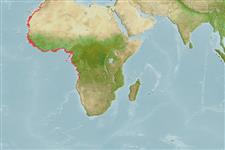ऐकटीनोप्टीरेजी (रेज़-फिन्नढ मछलियाँ) >
Perciformes (Perch-likes) >
Haemulidae (Grunts) > Haemulinae
Etymology: Brachydeuterus: Greek, brachys, eia = short + Greek, deuter = two (Ref. 45335).
पर्यावरण / जलवायु / सीमा
पारिस्थितिकी
; समुद्री; खारा बेनथोपिलाजिक; गहराई सीमा 10 - 100 m (Ref. 57395), usually 15 - 80 m (Ref. 26999). Tropical, preferred 25°C (Ref. 107945); 35°N - 16°S, 19°W - 14°E (Ref. 54289)
Eastern Atlantic: west coast of Africa, from Mauritania to Angola (Ref. 57395). Also reported from Morocco (Ref. 2135).
Length at first maturity / आकार / वज़न / Age
Maturity: Lm 14.8 range ? - ? cm
Max length : 30.0 cm TL पुल्लिंग / अलिंग; (Ref. 57395); common length : 23.0 cm TL पुल्लिंग / अलिंग; (Ref. 3660)
पृष्ठीय रीढ़ (सम्पूर्ण): 10 - 13; पृष्ठीय सौफट रेज़ (सम्पूर्ण): 11-14; गुदा कांटा 3; ऐनल सौफट रेज़: 9 - 10. Diagnosis: body oblong and compressed; dorsal profile slightly and regularly convex; snout shorter than eye diameter (Ref. 57395). Mouth large, oblique (Ref. 5377, 57395) and protrusible (Ref. 57395). Lower jaw slightly prominent; 2 anterior pores on chin, followed by a median pit bearing openings of two large pores (Ref. 57395). Eyes large (Ref. 5377). Dorsal fin deeply notched; caudal fin deeply forked; scales ctenoid on body and head (Ref. 57395).
Coloration: back olivaceous, sides silvery to white; dark spot at angle of opercle; sometimes several small, dark spots on dorsal-fin base (Ref. 57395). Fins grey (Ref. 5377).
Inhabits coastal waters (Ref. 2683). Semipelagic, remains near the bottom during the day and moves up to the open water at night (Ref. 5377, 57395). Occasionally enters lagoons and estuaries at start of sexual maturation (Ref. 57395). Occurs over sandy and muddy bottoms. Feeds on invertebrates and small fishes (Ref. 5535).
Life cycle and mating behavior
परिपक्व अवधि | पुनरुत्पत्ति | मछलीऔ का अंडे देना | अंडे | Fecundity | लार्वा
Distinct pairing during breeding (Ref. 205).
Roux, C., 1990. Haemulidae. p. 783-788. In J.C. Quero, J.C. Hureau, C. Karrer, A. Post and L. Saldanha (eds.) Check-list of the fishes of the eastern tropical Atlantic (CLOFETA). JNICT, Lisbon; SEI, Paris; and UNESCO, Paris. Vol. 2. (Ref. 6946)
IUCN Red List Status (Ref. 115185)
CITES (Ref. 94142)
Not Evaluated
Threat to humans
Harmless
Human uses
मात्स्यिकी: उच्च वाणिज्य
अधिक जानकारी
संदर्भजलीयकृषिजलीयकृषि रूपरेखाखींचआनुवंशिकीऐल्लि आवृतियाँहैरेटिबिलटीबीमारीप्रक्रमणMass conversion
सहयोगीयोतस्वीरेStamps, Coinsध्वनिसिगुयटिरारफ्तारतैरने के प्रकारगिल क्षेत्रOtolithsदिमागदृष्टि
साधन
Special reports
Download XML
इंटरनेट स्रोत
